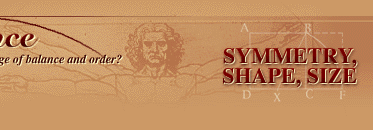  |
 The recovery of ancient manuscripts showed the humanists how the Greeks and Romans employed mathematics to give structure to their art. The relationship between these two studies is most evident in architecture, where numerical ratios were used in building design. A ratio is nothing more than a relationship between two quantities. For example, a building that is 100 feet wide and 50 feet tall has a ratio between its width and its height of 2:1 (100:50 = 2:1). Proportions in Architecture
The humanists also used the writings of Vitruvius, a Roman architect, to guide them in their architectural designs. Vitruvius extolled the virtues of proportion and symmetry in architecture, and he explained how the human body represented the beauty of proportion in nature. Renaissance architects, especially those in Italy, also went to the ruins of ancient buildings to measure them and learn how proportion and symmetry were applied in real structures. The result of these studies was a new philosophy of beauty in building. Gothic spires and decorations imitating movement towards heaven were replaced by elegant symmetry demonstrating the intellect of man. Read more about Renaissance architecture, painting, and music. | |